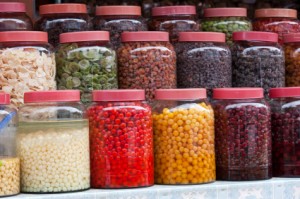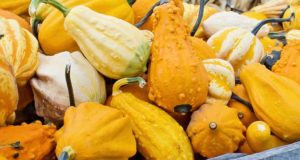 Preserving our produce in a variety of methods can be done to extend our garden’s harvest season. Today I would like to discuss drying [dehydrating] our fruits and vegetables and how to store them once they are completely dry. Most people interested in dehydrating foods usually run out to the department store and buy a dehydrator to set on their countertops. Not only is this costly in terms of initial output. It also requires electricity to power the machine.
Preserving our produce in a variety of methods can be done to extend our garden’s harvest season. Today I would like to discuss drying [dehydrating] our fruits and vegetables and how to store them once they are completely dry. Most people interested in dehydrating foods usually run out to the department store and buy a dehydrator to set on their countertops. Not only is this costly in terms of initial output. It also requires electricity to power the machine.
We should have most of what is needed for drying our produce already in our kitchen. What we may be lacking is relatively inexpensive, easy to find and reusable. We can dry all of our fruits and vegetables using little or no electricity or gas in the process.
Equipment
- Two or more cookie trays – the kind with sides.
- Plastic canvas – to fit in the bottom of our trays. This can be purchased at craft markets, fabric stores, and sometimes in the craft area of your local Wal-Mart or Target.
- Cheesecloth – to cover our trays [to keep bugs out]. This can usually be found in the house wares departments of Wal-Mart or Target. I have also found it in my local health food store and online at Amazon. I have also found that a worn, white T-shirt works just as well, maybe better as you can slide the trays inside them and not worry about the trays getting easily uncovered.
Drying your Produce
Decide what you are drying and how much.
- Wash and dry your cookie trays and place the plastic canvas in the bottom of each tray to be used.
- Cut your veggies into ¼ inch to ½ inch slices. Heavier, or denser, veggies will take longer to dry than those that weigh less as they contain more water. So you may want to make them thinner when cutting them up.
- Fill your trays – one level deep, please, so they will dry faster. It also helps to leave a little room around each slice.
- Cover trays with cheesecloth. Place in a warm place to dry. If the day is hot and you have a table or other flat area outside in the shade then place your trays outside out of direct sunlight to dry. Direct sunlight will breakdown the nutritional value of your produce. Drying outside is quicker than drying indoors and will not have any expenses due to energy usage. If you are unable to dry outside, using any flat surface indoors is a great option as well. One of the handiest places for indoor drying is to place your trays on top of the refrigerator. It not only leaves your counter top free for other projects, it also has the added benefit of the heat that rises from the refrigerator to speed up the drying process. If you are in need of quicker drying, you may place your trays in your oven to dry. Pre-heat your oven to the lowest setting, 150-200 degrees. Check your trays occasionally for dryness by trying to break one or two pieces of produce. When your veggies break easily and you hear the crispness in their breaking, they are dehydrated and ready for storing.
- Pack your dried veggies in Ziploc bags, dry canning jars with lids securely tightened, seal-a-meal bags or in vacuum-sealed bags or containers. These can be safely stored on your pantry shelves 4-6 months if kept dry, or in your freezer for up to a year.
- Repeat the process until you have dried all of your chosen produce and put it up for future use.
Practice Drying
An easy fruit to practice with is bananas. Slice in ¼ inch slices and lay out on your trays as described above. You may want to dip in lemon or lime juice to avoid discoloring before setting out to dry. When your bananas are dry, the time it takes to dry them will give you some idea how long it will take for other things to dry.
Using your Dried Produce
Dried veggies can be put right into your stews and soups about 30 minutes before the dish is finished cooking. Dried produce can be eaten right from their storage containers as quick, healthy snacks. Dried veggies can also be used to make casseroles. For example about 2 cups of dried, sliced potatoes can be made into Scalloped Potatoes by following your favorite recipe and adding about 2 ½ cups of boiling water to your potatoes when putting your dish together.
Dried fruits can be re-hydrated in a little water and used in pies, cakes or cobblers like you would fresh, canned or frozen varieties. You can also add to cookie dough and a little extra liquid added to give them the needed moisture to plump them up almost to their pre-dried state.
Drying Herbs And Flowers
Drying your herbs and flowers is easy, too.
- Place your herbs and flowers into small bundles tied together with some pieces of twine.
- Hang your bundles with the cut ends up either outside away from direct sunlight or in a cool, dark room – like a storage shed or in your pantry. Putting them with the cut ends up sends the nutrients and colors into the blooms of your flowers or the leaves of your herbs as the water evaporates from the cut ends.
- Using a length of twine to string across your drying area like a clothes line will allow you to pin your bundles from the line with clothespins while they dry.
- Store your dried herbs as described above for fruit and veggies.
- Use your dried flowers in arrangements to beautify your home or brighten the day of a friend or loved one. They will last indefinitely.
Experiment with your bountiful harvest of dried produce, herbs and flowers; you may just create a great, new favorite dish in the process. Enjoy!
 Off The Grid News Better Ideas For Off The Grid Living
Off The Grid News Better Ideas For Off The Grid Living



